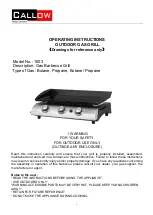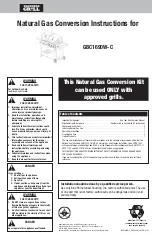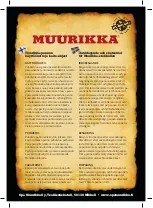
6.CARE AND MAINTENANCE
Cooking surfaces
Maintaining the burners
Heat diffuser
Grease collection tray
• When the barbecue has cooled down, clean it with warm, soapy water. To remove food residue, use a dish-
washing detergent. Do not use abrasive sponges or scouring powders as they could permanently damage the
finish of your barbecue. Rinse and dry well. We do not recommend cleaning the grills and plates in a dishwasher
because of their weight.
• REMEMBER THAT THE USE OF ICECUBES, WHICH MAY CAUSE THERMAL SHOCK AND CRACK THE ENAMEL OF THE
PLATE, MUST BE AVOIDED.
• IF RUST APPEARS ON THE COOKING SURFACE IN CONTACT WITH THE FOOD, IT MUST BE REPLACED.
• Your burner has been set to provide maximum flame performance. You will normally see a blue flame, that maybe
has a yellow end, when the burner is lit. If the flame tends to be more yellow, it could be due to debris or insects
in the holes or tubes of the burner. This could cause a blockage or restriction of the gas flow, which could cause a
fire behind the control panel, seriously damaging your barbecue. If this happens, and if possible, the gas must be
switched off immediately.
• The burner must be inspected, removed and cleaned regularly, at least once a year, in addition to the following
conditions:
• Removing your barbecue from storage.
• If one or more burners do not ignite.
• If the flame of the burner is too yellow.
• If the gas ignites behind the control panel.
• To clean a burner completely, remove it from the barbecue. A lightweight wire brush can be used to remove rust
from the burner surface. Use a pipe cleaner or a piece of wire to remove obstructions in the holes or tubes of the
burner, taking care not to enlarge the burner holes.
• You may need a torch to ensure that the inside of the burner tube is clear. Turn the burner and tap it gently against
a hard surface like a piece of wood to dislodge any debris from the inside.
• When replacing the burner, make sure that the tubes are facing the nozzles.
• Remove any food residue from the heat diffuser with a wooden or soft plastic scraper or with a brass brush. Do not
use a steel scraper or brush. Clean with warm, soapy water and rinse thoroughly.
• After each use, remove and clean all food and fat deposits from the grease collection tray, using a wooden or
plastic scraper if necessary.
• If you do not follow these instructions, it may cause a grease fire. This could result in serious damage to your
barbecue that will not be covered by the warranty. If necessary, the grease collection tray can be cleaned with
soapy water.
EN
148
Summary of Contents for 2022R09P19-0009
Page 4: ...3 x2...
Page 5: ...4 30 30...
Page 68: ...1 1 OFF 2 3 50 50 4 EL 67...
Page 69: ...2 w EL 68...
Page 71: ...4 OFF 50 OFF 4 OFF 5 OFF EL 70...
Page 72: ...5 MINI OFF 3 5 3 5 EL 71...
Page 73: ...5 5 OFF 6 merguez EL 72...
Page 74: ...6 EL 73...
Page 75: ...6 EL 74...
Page 76: ...7 3 4 EL 75...
Page 77: ...8 Naterial Naterial Naterial 2 EL 76...
Page 92: ...1 1 2 3 50 50 4 2 91 RU...
Page 93: ...3 10 C ISO3821 1 5 2 10 24 RU 92...
Page 95: ...4 50 4 3 5 5 RU 94...
Page 96: ...5 3 5 RU 95...
Page 97: ...5 5 6 RU 96...
Page 98: ...6 RU 97...
Page 99: ...6 RU 98...
Page 100: ...7 3 4 RU 99...
Page 101: ...8 Naterial Naterial Naterial 2 RU 100...
Page 103: ...1 1 2 3 50 50 4 KZ 102...
Page 104: ...2 KZ 103...
Page 106: ...50 4 3 5 4 5 KZ 105...
Page 107: ...3 5 MIN 5 FONCTIONNEMENT KZ 106...
Page 108: ...5 5 FONCTIONNEMENT 6 KZ 107...
Page 109: ...6 KZ 108...
Page 110: ...6 C KZ 109...
Page 111: ...7 3 4 KZ 110...
Page 113: ...1 1 2 3 50 50 4 2 UK 112...
Page 114: ...3 2 10 24 10 ISO3821 1 5 6 5 EN16129 UK 113...
Page 116: ...5 3 5 4 3 5 UK 115...
Page 117: ...5 5 UK 116...
Page 118: ...6 5 UK 117...
Page 119: ...6 UK 118...
Page 120: ...6 7 3 4 UK 119...








































